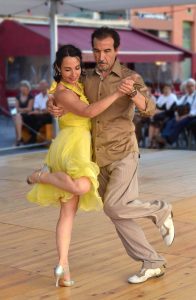Ballroom dance can mean many things, from DWTS to a bride and groom’s first dance. Just what falls under the ballroom umbrella?
What is ballroom dance anyway?
When people hear the words “ballroom dance,” sweeping gowns and royal balls are what most often comes to mind. While that’s not wrong — Cinderella definitely had some lessons — the world of ballroom dance encompasses endless varieties, genres, and styles of dance. In fact, almost any type of partner dance can be classified as ballroom dance — from country two step to salsa to waltz.
Ballroom Dances: how they came to be
Over time however, some dances have become more closely associated with ballroom than others. While older dances like the Polka or Minuet are now considered historic dances, the dances that have been accepted into the modern ballroom canon are the ones we can dance to modern/popular music. Any music you hear at a wedding, Latin club, or cruise are a good measure of which dances are still around, like hustle, salsa, and foxtrot.
Specialty Partner Dances
That’s not to say the only dances you can do are waltzes or rumbas. If you want to learn kizomba or Argentine tango, all you have to do is ask your teacher! These dances are considered specialty dances and are usually specific to a particular region or culture. Competition dancers won’t typically dance these highly stylistic dances at a competition, but your teachers will be able to give you a social version of them for you to enjoy.
So that begs the question, what is competitive dancing versus social dancing? And do they both fall under the ballroom umbrella?

Social Dancing vs. Competitive Dancing
A lot of students aren’t interested in competing when they first walk through the studio doors. Most are here to work on their posture, get more out of a wedding, or just to have a casual date night learning something new and fun together.
In other words, most Arthur Murray students are social dancers, or they have the ability to dance with anyone, anywhere, anytime. Of these social students, some will decide to take their dancing to a higher level and start to compete. Both are considered ballroom dancing and both are legitimate. It’s up to you and what goals you want to set for yourself.
International Ballroom vs. American Ballroom
Because most Arthur Murray students are social dancers, most study American style ballroom. If you do choose to take your dancing to the competitive world, however, you have another rift in the ballroom umbrella: International vs. American style.
When you search “ballroom” on YouTube, most of what comes up are International dance competitions. International style of dance is also referred to as dance sport, because the style of dancing does not lend itself as easily to social dancing. Here’s what else you need to know:
American Smooth vs. Standard dances
These dances are closely related, but American style features more break always between partners and open footwork. The dances are Waltz, Tango, Viennese waltz, and foxtrot.
International Standard has figures danced in closed dance position only. The dances are waltz tango, Viennese waltz, quickstep, and foxtrot.
American Rhythm vs. Latin Dances
Also fairly similar, American rhythm feature a sensual body movement, but are mostly danced in the US and Canada. The dances are rumba, mambo, cha cha, east coast swing, and bolero.
International Latin dances are danced with a different leg action compared to its American counterpart. Movement is very sharp and precise, hence the name dancesport. The dances are paso doble, cha cha, rumba, samba, and jive.
Can you learn international dance just for fun? Of course! No matter what path you choose to take with your dancing, the key thing is to enjoy it! Arthur Murray is a studio dedicated to ensuring every person can enjoy dancing, whether it be competitive or not.
So what are you waiting for? Find a studio near you!
Written by Jindalae Suh for Arthur Murray Central New Jersey













